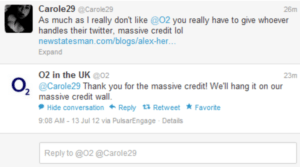6 Tips for Managing a Social Media Crisis
Social media has become an inevitable part of brand development. Any company, from small businesses to global corporations, should make an effort to turn their followers into brand advocates. Once a crisis hits, loyal brand advocates will be less likely to bash your brand and might even defend it. A social media crisis, similar to other types of crises, is a time of intense difficulty that requires decision makers to act immediately.
 O2, a leading mobile phone provider, recently dealt with a major customer backlash after a day-long network outage. The tweets sent out by their angry customers reached over a million people. Rather than appeasing them with the usual corporate jargon, O2’s social media team used light humor and personality instead. Their refreshing responses allowed them to deviate some of the negative attention. One thing O2 understood is that human interaction is the best way to communicate with customers.
O2, a leading mobile phone provider, recently dealt with a major customer backlash after a day-long network outage. The tweets sent out by their angry customers reached over a million people. Rather than appeasing them with the usual corporate jargon, O2’s social media team used light humor and personality instead. Their refreshing responses allowed them to deviate some of the negative attention. One thing O2 understood is that human interaction is the best way to communicate with customers.
These 6 tips can help you prevent a PR nightmare
Be prepared: Having a crisis communication plan is crucial to prevent permanent damage to your brand. You should be aware of your own weaknesses and brainstorm possible negative scenarios. A plan will make it easier to develop key messages and puts everyone at ease in tumultuous times.
Speed matters: The amount of time you take to respond to a crisis can have a significant effect on its outcome. Angry customers tend to be impatient and expect an immediate explanation. Due to the fast moving nature of social media, companies have no excuse for responding slowly. Trying to sit it out will only cause more frustration on the side of the customer.
Acknowledge and be transparent: The first response to a frustrated customer should always include an acknowledgement of their concern. Even if you haven’t found a solution yet, acknowledge that there is a problem. Denying a problem will make it seem like you are not taking it seriously. In any communication that follows it’s important to be transparent in order to regain your credibility.
Respond with a consistent message: Every social media crisis should be coordinated by a designated person or team to make sure everyone is pulling on the same string. All employees should be informed and constantly updated about the crisis. Getting everyone on the same page will ensure that consistent messages are sent out on all platforms that can possibly reach the customer.
Constant Monitoring: Once a crisis arises, it should be closely monitored. It allows you to respond to and engage with customers in real time. Harmful statements about your brand can be addressed immediately or deleted if necessary. Being the first one to respond to negative feedback allows you to protect your brand and make your voice heard.
Learn: After the storm is over, every company should evaluate what caused the crisis and how it was managed. Interactions with customers on social media should be archived and analyzed. Ask yourself: Who was mostly affected by the problem? Was the crisis protocol effective? What can be done to prevent such a crisis from happening in the future?
The primary goal of crisis management is turning the crisis into an opportunity. Easier said than done! Even though preparation, timeliness, and consistency are all important factors in crisis communication, the O2 example showed that being authentic and human can be the tipping point.
Are you trying to turn your followers into brand advocates? If you have any questions about social media management, give us a call at 504-521-6222 and we’ll start crafting the perfect social media strategies for you.
